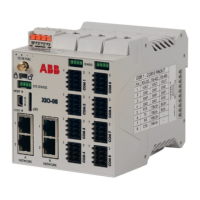XIO USER MANUAL | 2106424MNAA | 189
Configuration
Remote communication over a TCP/IP network requires that:
– Valid IP addresses are available for both the laptop and the XIO.
– Network equipment is available (with links that are active and reliable), or additional equipment
supports daisy-chain connections.
– A DCHP server is available on the network or on the local switch/router equipment if you configure
the XIO for dynamic addressing.
Table 10-4
describes the configuration for the remote host, the XIO, and PCCU for communication over a
network.
When configured as one network (1 Network mode), Enterprise or
Ethernet port 1 and port 2, are physically separate but do not have separate
or IP addresses in the user interface. When you enable, disable or configure
, it enables, disables or configures both ports. Both port sets are assigned a single
regardless of the Ethernet port (1 or 2) used for the network connection.
Table 10-4: Configuration for remote communication with networked XIO (ports A1 or A2)
interfaces
Ethernet interface is
enabled:
Verify the Local Area
Connection is enabled.
Verify the Ethernet
link is active.
In PCCU Entry mode, go to
Communications>Networking:
4 port switch option must be selected
(Enabled).
Ethernet interface:
Port: A1+A2+B1+B2
State: Enable
For
communications,
select TCP/IP.
For connection
parameters, type
the IP address
assigned to the
XIO.
If the IP address is
assigned by DHCP,
obtain the address
from the
Networking tab
after the XIO is
restarted.
parameters
either through DHCP
or manually
configured
Change factory default IP parameters for
valid public IP
parameters and restart the
XIO.
In PCCU Entry mode, go to
Communications>Networking:
For dynamic addressing:
Set DHCP to Yes (Enable DHCP).
For static addressing:
Obtain valid public IP parameters from
network administrator and configure
manually.
10.4.4 Device-to-device communication
Device-to-device communication includes the communication flow between Totalflow applications running
on the different devices installed in the field and connected through a network.
Using client-server-based communication, client applications on one device can request and establish a
TCP/IP connection to a server application on another device.
In the case of the XIO, its core functionality depends on secure and stable TCP/IP based connections with
a remote controller. These connections must have their end points correctly configured for communication
to establish and succeed.
Table 10-5
shows the connections required for successful implementation of XIOs. These connections
require that the end points (responsible for establishing and maintaining the connection), be on devices
connected to the same network. Each application end point must be configured with a unique IP address
valid for that network.
When configuring IP parameters consider the following:

